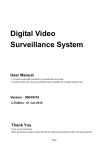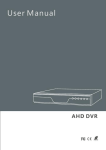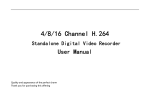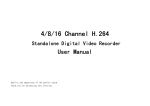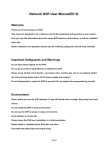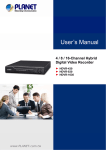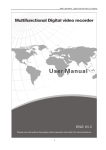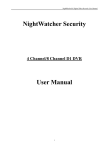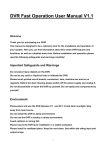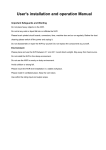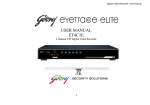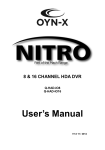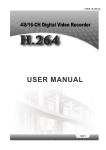Download DVR User Manual For 9400Series
Transcript
www.cctv-auckland.com 4/8 Channel H.264 Standalone Digital Video Recorder User Manual Quality and appearance of the perfect charm Thank you for purchasing this offering INDEX Welcome..........................................................................................................................................................................................................................................................5 Important Safeguards and Warnings...............................................................................................................................................................................................................5 Environment.................................................................................................................................................................................................................................................... 6 1 Production Introduction....................................................................................................................................................................................................................................... 7 1.1 Product overview...................................................................................................................................................................................................................................... 7 1.2 Main functions.......................................................................................................................................................................................................................................... 7 2 Open-package check and cable connections........................................................................................................................................................................................................9 2.1 Open-package check................................................................................................................................................................................................................................. 9 2.2 Hard disk installation.............................................................................................................................................................................................................................. 10 2.3 Front panel...............................................................................................................................................................................................................................................11 2.4 Rear panel................................................................................................................................................................................................................................................12 2.5 Audio and video input and output connections.......................................................................................................................................................................................15 2.5.1 Video input connections...............................................................................................................................................................................................................15 2.5.2 Video output connections and options......................................................................................................................................................................................... 16 2.5.3 Audio signal input........................................................................................................................................................................................................................ 16 2.5.4 Audio signal output...................................................................................................................................................................................................................... 16 2.6 Alarm input and output connections....................................................................................................................................................................................................... 17 2.6.1 Alarm input port specification..................................................................................................................................................................................................... 20 2.6.2 Alarm output port specification................................................................................................................................................................................................... 20 2.6.3 Alarm output port relay parameters............................................................................................................................................................................................. 20 2.7 Speed dome connections.........................................................................................................................................................................................................................20 3 Basic operation...................................................................................................................................................................................................................................................21 3.1 Turn on.................................................................................................................................................................................................................................................... 21 3.2 Turn off....................................................................................................................................................................................................................................................21 3.3 Login....................................................................................................................................................................................................................................................... 22 3.4 Preview....................................................................................................................................................................................................................................................23 2 3.5 Desktop shortcut menu............................................................................................................................................................................................................................23 3.5.1 Main menu................................................................................................................................................................................................................................... 23 3.5.2 Window switch.............................................................................................................................................................................................................................24 3.5.3 Pan/Tilt/Zoom.............................................................................................................................................................................................................................. 24 3.5.4 Color Setting................................................................................................................................................................................................................................ 28 3.5.5 Record.......................................................................................................................................................................................................................................... 28 3.5.6 Alarm Output................................................................................................................................................................................................................................29 3.5.7 Search(Video playback)..........................................................................................................................................................................................................29 4 Main menu..........................................................................................................................................................................................................................................................32 4.1 Main menu navigation............................................................................................................................................................................................................................ 32 4.2 General Config........................................................................................................................................................................................................................................ 34 4.3 Poll function............................................................................................................................................................................................................................................ 34 4.4 Schedule function....................................................................................................................................................................................................................................35 4.5 Encode function...................................................................................................................................................................................................................................... 36 4.6 RS232 Config..........................................................................................................................................................................................................................................37 4.7 PTZ Config..............................................................................................................................................................................................................................................38 4.8 NetWork function....................................................................................................................................................................................................................................38 4.9 Alarm function........................................................................................................................................................................................................................................ 41 4.10 Detect function...................................................................................................................................................................................................................................... 42 4.10.1 Motion Detect............................................................................................................................................................................................................................ 42 4.10.2 Video Loss..................................................................................................................................................................................................................................43 4.10.3 Camera Masking........................................................................................................................................................................................................................ 43 4.11 Display function.................................................................................................................................................................................................................................... 44 4.12 Advanced function................................................................................................................................................................................................................................ 44 4.12.1 Abnormity.................................................................................................................................................................................................................................. 45 4.12.2 HDD Management..................................................................................................................................................................................................................... 45 4.12.3 Back up.......................................................................................................................................................................................................................................46 4.12.4 Account...................................................................................................................................................................................................................................... 46 4.12.5 Default........................................................................................................................................................................................................................................48 4.12.6 Auto Maintenance...................................................................................................................................................................................................................... 48 3 4.12.6 Shutdown................................................................................................................................................................................................................................... 49 4.13 Info function..........................................................................................................................................................................................................................................49 4.13.1 BPS.............................................................................................................................................................................................................................................50 4.13.2 Online users................................................................................................................................................................................................................................50 4.13.3 Log............................................................................................................................................................................................................................................. 50 4.13.4 Version........................................................................................................................................................................................................................................51 5 FAQ and maintenance........................................................................................................................................................................................................................................ 52 5.1 FAQ......................................................................................................................................................................................................................................................... 52 5.2 Maintenance............................................................................................................................................................................................................................................ 59 Appendix 1.Remote controller operation..............................................................................................................................................................................................................61 Appendix 2.Hard disk capability calculation........................................................................................................................................................................................................61 Appendix 3.Remote Control................................................................................................................................................................................................................................. 63 1 Network Connection.................................................................................................................................................................................................................................. 63 2. Remote Monitoring................................................................................................................................................................................................................................... 63 2.1 Central Management System client software(it's option for DVR)....................................................................................................................................................... 63 2.2 WEB........................................................................................................................................................................................................................................................ 64 3. Basic Web Operation.................................................................................................................................................................................................................................65 4 Welcome Thank you for purchasing our DVR! This manual is designed to be a reference tool for the installation and operation of your system. Here you can find information about this series DVR features and functions, as well as a detailed menu tree. Before installation and operation please read the following safeguards and warnings carefully! Important Safeguards and Warnings Do not place heavy objects on the DVR. Do not let any solid or liquid fall into or infiltrate the DVR. Please brush printed circuit boards, connectors, fans, and machine box and so on regularly. Before the dust cleaning please switch off the power supply and unplug it. Do not disassemble or repair the DVR by yourself. Do not replace the components by yourself. 5 Environment Please place and use the DVR between 0℃ and 55℃.Avoid direct sunlight. Stay away from heat source. Do not install the DVR in damp environment. Do not use the DVR in smoky or dusty environment. Avoid collision or strong fall. Please insure the DVR level installation in a stable workplace. Please install in ventilated place. Keep the vent clean. Use within the rating input and output scope. 6 1 Production Introduction 1.1 Product overview The 4/8/16 CH series DVR is designed specially for security and defense field which is an outstanding digital surveillance product. It introduces embedded LINUX operating system that is more stable. It introduces standard H.264mp video compressed format and G.711A audio compressed format, which insures the high quality image, low error coding ratio and single frame playing. It introduces TCP/IP network technology that achieves the strong network communication ability and telecommunication ability. The series DVR can be used individually or online applied as a part of a safety surveillance network. With the professional network video surveillance software it achieves the strong network communication ability and telecommunication ability. The series DVR can be applied in the bank, telecom, electric power system, judicial system, transportation, intelligent housing, factory, storehouse, water conservancy and so on. 1.2 Main functions Real-time surveillance ·Analog interface and VGA interface (HD VGA) ·Surveillance function through monitor or display ·Monitor and display simultaneous display,independent operate the main menu Storage ·Non-working hard disk dormancy processing which is convenient to radiate heat, reduce power and extend the life span ·S.M.A.R.T HDD Backup ·Through SATA interface and USB interface such as USB equipment, removable hard disk and so on ·Through net download the files in the hard disk Playback ·Individual real-time video recording as well as searching, playback, network surveillance, recording check, downloading and so on ·Multi-channel playback ·zoom at arbitrary region Net operating ·through net tele-surveillance in the real time ·tele-PTZ control ·tele-recording check and real-time playback Alarm linkage ·Multi-route relay alarm output, which is convenient for the alarm linkage and light control at the spot ·Protecting circuits at the alarm input and output interface which protects the main machine from damage Communication interface ·RS485 interface which fulfills the alarm input and PTZ control ·Standard Ethernet network interface which fulfills the telecommuting function intelligent operating ·Mouse action function 8 ·Fast copy and paste operating for the same setting 2 Open-package check and cable connections 2.1 Open-package check When you receive the DVR, please check first. First, please check whether there is any visible damage to the package appearance. The protective materials used for the package of the DVR can protect most accidental clashes during transportation. Then, please open the box and get rid of the plastic protective materials. Check whether there is any visible damage to the DVR appearance. At last, please open the machine crust and check the data wire in the front panel, power wire, the connection between the fan power and the main board. Front panel and rear panel The key function specification in the front panel and the interface specification in the real panel are in the specification. Please check the product type in the front panel whether is accordant with the product type you order. The label in the real panel is very important for the after service. Please protect it carefully. When you contact us for after service, please provide the product type and serial number in the label. 9 2.2 Hard disk installation First check the initial installation, install a hard drive (SATA ), the series of drive installation refer to the following: HS8004 One hard disk(2TB) HS8008 Two hard disk(2TB) HS8016 Two hard disk(2TB) Install the hard steps: ①Remove the screws on both sides of shell ②Gently break apart the cover and put the back-end ③Then, extracted from the next cover up ④fix the screw of hard disk ⑤connect the power wire and Cable ⑥Installation of the superstructure, the first front-end alignment 10 ⑦The back-end, gently break apart, and under the pressure Gehao ⑧fix the screw of Chassis Side 2.3 Front panel Front panel diagram, please mainly in kind. No. Icon / Connector Function Function Description Channel1 View the channel 1 1 Channel2 View the channel 2 11 Channel3 View the channel 3 Channel4 View the channel 4 2 Shift/Quad Switch the channel from 1 to 4 3 Remote Control Receiver Terminal Use for connecting with remote control 4 Arrow keys select the menu option; Up and down keys: to change the settings options or numerical size; preview screen to switch; Left and right keys: switch the selected controls; In the text entry box, enter the number on 1, down 2 (letters abc), left 3 (letters def), Right 4 (letters ghi) 5 Power switch Running in the system directly boot software shutdown, and software 6 USB U disk upgrade or mouse and other USB devices 2.4 Rear panel 12 4-CH rear panel diagram schematic, please mainly in kind 54 No. Physical interface / logo ID Description 1 VIDEO IN Video input connector, 4-CH two rows of two of four(BNC) 2 VIDEO OUT Video output, then the monitor, or other TV equipment 3 AUDIO-OUT Audio output connector(BNC) 4 NET/LAN Network Interface 5 USB BACKUP USB interface (can be used for U-disk backup or mouse) 6 DC-12V 12V Power Interface 7 Power switch Power switch, hit the dot at the start 8 AUDIO-IN Audio input connector(BNC), 2-CH 9 VGA VGA display interface (optional) 10 ALARM,I/O,COM Alarm input and output interface, PTZ interface, etc. (see Alarm Interface specific description) 8-CH rear panel diagram schematic, please mainly in kind 13 No. Icon / Connector Function Function Description 1 MULTI Used for showing single, 4, 8, 9 and 16 preview 2 CH+ Increase channel 3 CH- Reduce channel PTZ 4 5 PTZ Control MENU Control the machine into the MENU 14 6 ESC Control the machine out the MENU 7 Power switch Running in the system directly boot software shutdown, and software 8 REC Record 9 PLAY Play the video 10 STOP Stopped playing 11 STEP fast-forward 12 BACK Playback 13 QPLAY Video playback Arrow keys Select the menu option; Up and down keys: to change the settings options or numerical size; preview screen to switch; Left and right keys: switch the selected controls; In the text entry box, enter the number on 1, down 2 (letters abc), left 3 (letters 14 15 def), Right 4 (letters ghi) 15 USB U disk upgrade or mouse and other USB devices No. Physical interface / logo ID Description 1 VIDEO IN Video input connector, 8-CH two rows of four of four(BNC) 2 AUDIO-IN Audio input connector(BNC), 4-CH 3 VIDEO OUT Video output, then the monitor, or other TV equipment 4 VGA VGA display interface (optional) 5 NET/LAN Network Interface 6 ALARM,I/O,COM Alarm input and output interface, PTZ interface, etc. (see Alarm Interface specific description) 16 7 DC-12V 12V Power Interface 8 AUDIO-OUT Audio output connector(BNC) 9 USB BACKUP USB interface (can be used for U-disk backup or mouse) 10 Power switch Power switch, hit the dot at the start 2.5 Audio and video input and output connections 2.5.1 Video input connections The video input port is BNC connector plug. The demand of input signal is PAL/NTSC BNC(1.0VP-P,75Ω). The video signal must be accorded with the state standard, which has the high signal to noise ratio, low aberration and low interference. The image must be clear and has natural color in the appropriate brightness. Insure the vidicon signal stable and credible The vidicon should be installed in the appropriate location where is away from backlighting and low illumination or adopts the better backlighting and low illumination compensation. The ground and power supply of the vidicon and the DVR should be shared and stable. Insure the transmission line stable and credible The video transmission line should adopt high quality coaxial pair, which is chosen by the transmission distance. If the transmission distance is too far, it should adopt shielded twisted pair, video compensation equipment and transmit by fiber to insure the signal quality. The video signal line should be away from the electro magnetic Interference and other equipments signal lines. The high voltage current should be avoided 17 especially. Insure the connection stable and credible The signal and shield lines should be firm and connected credible which avoid false and joint welding and oxidation. 2.5.2 Video output connections and options The video output is divided into PAL/NTSC BNC (1.0VP-P,75Ω) and VGA output(selective configuration). When replace the monitor by the computer display, there are some issues to notice. 1、Do not stay in the turn-on state for a long time. 2、Keep the computer display normal working by demagnetizing regularly. 3、Stay away from the electro magnetic Interference. TV is not a credible replacement as a video output. It demands reducing the use time and control the power supply and the interference introduced by the nearby equipments strictly. The creep age of low quality TV can lead to the damage of other equipments. 2.5.3 Audio signal input Audio port is BNC connection. The input impedance is high so the tone arm must be active. The audio signal line should be firm and away from the electro magnetic Interference and connected credible which avoid false and joint welding and oxidation. The high voltage current should be avoided especially. 18 2.5.4 Audio signal output Commonly the output parameter of DVR audio signal is greater than 200mv 1KΩ(BNC), which can connect the low impedance earphone and active sound box or other audio output equipments through power amplifier. If the sound box and the tone arm can not be isolated, howling phenomena is often existed. There are some methods to deal with the above phenomena. 1. Adopt better directional tone arm. 2. Adjust the sound box volume to be under the threshold that produces the howling phenomena. 3. Use fitment materials that absorb the sound to reduce reflection of the sound. 4. Adjust the layout of the sound box and the tone arm. 2.6 Alarm input and output connections 1、Alarm input A. Alarm input is grounding alarm input. B. Alarm input demand is the grounding voltage signal. C. When the alarm is connected with two DVRs or connected with DVR and other equipments, it should be isolated by relay. 2、Alarm output Alarm output can not be connected with high-power load (no more than 1A). When forming the output loop it must prevent the big current from relay damage. Use the contact isolator when there is a high-power load 3、PTZ decoder connections A. The grounding of the PTZ decoder and DVR must be shared otherwise the common-mode voltage will lead to the PTZ control failure. The shielded twisted pair 19 is recommended. B. Avoid the entrance of high voltage. Make the layout reasonably. Take precaution from the thunder. C. In the outlying end connect 120Ω resistance paralleled to reduce the inflection and insure the signal quality. D. The 485 AB lines of DVR can not connected with other 485 output equipments paralleled. E. The voltage between the AB lines of the decoder must be less than 5V. 4、Front equipment grounding note Bad grounding can lead to the burnout of the chip. 2.6.1 Alarm input port specification 1 channels alarm input. Alarm input type unlimited. The grounding and the com port of the alarm sensor are parallel (The alarm sensor is external power supply). The grounding of the alarm and the DVR should be shared. The NC port of the alarm sensor must be connected with the DVR alarm input port. The grounding of the power supply and the alarm sensor must be shared when used in external power supply. 2.6.2 Alarm output port specification 1 channels alarm output. There is external power supply when using the external alarm equipment. Please refer to the relay relevant parameters to avoid the overload that damages main machine. 20 2.6.3 Alarm output port relay parameters 2.7 Speed dome connections 1、Connect the 485 lines of the speed dome with the DVR 485 interface. 2、Connect the video line with the DVR video input. 3、Electrify the speed dome. 21 3 Basic operation Note: The button in gray display indicates nonsupport. 3.1 Turn on Plug the power supply and turn on the power supply switch. Power supply indicator light shining indicates turning on the video recorder. After the startup you will hear a beep. The default setting of video output is multiple-window output mode. OSD menu default is VGA output, If you need to monitor for menu operation, adjustment shall be front panel 【Switch display key】function key or【main menu】→【display】→【display mode】to switch between output operation. If the startup time is within the video setting time, the timing video recording function will start up automatically. Then the video indicator light of corresponding channel is shining and the DVR is working normally. Note:1. Make sure that the input voltage corresponds with the switch of the DVR power supply. 2. Power supply demands: 220V±10% /50Hz. Suggest using the UPS to protect the power supply under allowable conditions. 3.2 Turn off There are two methods to turn off the DVR. Entering 【main menu】and choosing 【shutdown】 in the【shutdown】 option is called soft switch. Pressing the power supply switch is called hard switch. Illumination: 1、Auto resume after power failure If the DVR is shut down abnormally, it can automatically backup video and resume previous working status after power failure. 2、Replace the hard disk Before replacing the hard disk, the power supply switch in the real panel must be turned off. 3、Replace the battery Before replacing the battery, the setting information must be saved and the power supply switch in the real panel must be turned off. The DVR uses button battery. The system time must be checked regularly. If the time is not correct you must replace the battery, we recommend replacing the battery every year and using the same battery type. Note: The setting information must be saved before replacing the battery otherwise information will lose. 3.3 Login When turn on the DVR, the system will automatically to show the SYSTEM LOGIN interface, please sees the picture, then you can login under admin user name and the password is empty, the system provides the corresponding functions with the admin purview. There is a default user. The name is admin, the password is 12345. Password protection: If the password is continuous wrong three times, the alarm will start. If the password is continuous wrong five times, the account will be locked. (After reboot or half an hour, the account will be unlocked automatically) For your system security, please modify your password after first login. 23 3.4 Preview You can left click mouse to choose the switch between the windows. The system date, time and channel name are shown in each viewing window. The surveillance video and the alarm status are shown in each window. 1 Recording status 3 Video loss 2 Motion detect 4 Camera lock 3.5 Desktop shortcut menu In preview mode you can right click mouse to get a desktop shortcut menu. The menu includes: main menu, View 1, View 4, Pan/Tilt/Zoom, Color Setting, Record, Alarm Output, Search. 3.5.1 Main menu When you login, the system main menu is shown as below. 24 3.5.2 Window switch Preview in single window/four windows/eight windows/nine windows according to the choice. 3.5.3 Pan/Tilt/Zoom Operation interface is as followed. The functions include: PTZ direction control, step, zoom, focus, iris, setup operation, patrol between spots, trail patrol, boundary scan, assistant switch, light switch, level rotation and so on. Note1. Decoder A(B)line connects with DVR A(B)line. The connection is right. 1、 2. Click desktop shortcut menu > Pan/Tilt/Zoom >Set to set the PTZ parameters. 3. The PTZ functions are decided by the PTZ protocols. 【speed】Set the head rotation amplitude, the larger the number, the greater the range, setting range: 1 to 8. 【zoom】Click - / + button to adjust the zoom multiple of the camera. 【focus】Click - / + button to adjust the focus of the camera . 【iris】Click - / + button to adjust the iris of the camera. 【direction control】Control the PTZ rotation. 8 directions control is supportive.(4 directions in Front panel is supportive ) 【high speed PTZ】Full-screen show channel image. Left press mouse and control PTZ to rotate orientation. Left press mouse and then rotate the mouse to adjust the zoom multiple of the camera. 【set】Enter the function operation menu. 25 Special functions: 1、Preset Set a location for the preset, calls the preset points, PTZ automatically turn to the setting position 1)Preset option Set a location for the preset, procedure is as follows: Step1: in PTZ control , click the Direction button will turn into preset position, click the Settings button to enter Picture Step 2: click the Preset button, and then write the preset points in the input blank, Step 3: click Settings button, return the PTZ control Complete setup, that is the preset points and preset position corresponds. Clear Preset:Input preset points, click Remove button, remove the preset。 2)Preset Point Calls In PTZ control, click Next Page, enter PTZ control interface as shown in right Picture. In the input blank, write the preset points, then click Preset button, PTZ turn to the corresponding preset point. 2、Tour between Points Multiple preset points connected cruise lines, call cruise between points, the PTZ run around on the line 1)Tour Between Points Settings Tour lines is connected by multiple preset points, setting procedure is as follows: Step1: In PTZ Control, the Direction key will turn PTZ to designated location, click Set button to enter PTZ Config, 26 Step 2: click Tour buttons, the write proper value into the Tour Line and Preset Points blank,then click Add Preset Points button, complete setting (also can add and delete tour line which has been set up) Step 3: repeat step1 and step2 , until set out all the preset designated tour lines。 Remove Preset:Please input preset value in the blank, click Remove Preset button, and then remove the preset points. Remove Cruise Line:Input the number of tour line, click Remove Tour Lines button, then remove the tour lines set。 2)The Calls of Cruise between Points In PTZ Control, click Next Page, enter PTZ config menu. Please input the number of cruise in the value blank, then click Cruise between Points button, PTZ begins to work on the cruise line. Click Stop button to stop cruise. 3、Pattern PTZ also can work on the preset pattern line repeatedly. 1)Scan setup Step1:In PTZ Control, click Set button; Step2:Click Pattern button,the input proper value in the Pattern value blank; Step3:Click Begin button, enter PTZ control menu,here you can set the following items: Zoom、Focus、Aperture、 Direction and so on. Click Set button to go back right Picture; Step4:Click End button to complete setup。Click the right button of the mouse to exit. 2)Scan Calls In the Pan/Tilt/Zoom menu, click next Page, enter PTZ config interface. Please input the number of scan in the value 27 blank , then click Scan button,PTZ begins to work on the scan line . Click Stop button to stop.。 4、Boundary Scan Boundary Scan setup Step1:In PTZ Control, click Set button to turn the PTZ to preset direction, then click Boundary button enter right Picture, then select the right boundary, return to PTZ Control Step2:Please click direction arrows to adjust PTZ direction, click set button enter right Picture, then select the right boundary, return to PTZ Control; Step3: Complete setup that is the position of left and right boundary Step4: In PTZ Control, click set button . Please input the number of scan in the value blank , then return PTZ Control,PTZ begins to work on the scan line . 5、Horizontal Rotating Click Horizontally Rotating button, PTZ begins to rotate horizontally (relative to the original position of the camera). Click the Stop button to stop. 6、Rotate Click on horizontal Rotating button, PTZ turn around. 7、Reset PTZ restart, all the data clears to 0.。 8、Other Settings In PTZ Control, click next Page button twice into right Picture, setting auxiliary function. Auxiliary number corresponding to auxiliary switch on the decoder. 【Intuitive Auxiliary Operation】 choose auxiliary equipment, select Open or Close button, switch control; 28 【Auxiliary Number】The operation of corresponding auxiliary switch according to PTZ agreement; 3.5.4 Color Setting Set the selective image parameters (current channel for single window display and cursor place for multi-window display). You can use the desktop shortcut menu and enter the interface. The image parameters include: tonality, brightness, contrast, and saturation. You can set different parameters at different time sections. 3.5.5 Record Please check current channel status: “○” means it is not in recording status, “●” means it is in recording status. 【Schedule】Video settings video set by the (time, dynamic examination and alarm) the type of video recording. 【 Manual 】 The highest priority, no matter what the current status of each channel in the implementation of "Manual" button, the corresponding video channels all the time. 【All】Click the all button and the according channel is recording no matter the channel in any state. 【stop】Click the stop button and the according channel stops recording no matter the channel in any state. 3.5.6 Alarm Output Please check current channel status: “○” means it is not in alarming status, “●” means it is in alarming status. 29 【Schedule】System configuration according to the alarm signal output alarm signal. 【Manual】The highest priority, no matter what the current status of each channel in the implementation of "Manual" button, the system will immediately initiate an alarm signal. 【Stop】Click the stop button and the according channel stops alarming no matter the channel in any state. 3.5.7 Search(Video playback) There are two methods for you to play the video files in the hard disk. 2、 In the desktop shortcut menu. 3、 desktop shortcut menu >Search. Note: The hard disk that saves the video files must be set as read-write or read-only state. 2 1 3 1. Playback area 2. Channel No. 3. Video list 4. Video Information 5. Toolbar 【Playback area】Video playback area to display single or multi-channel 4 5 【Channel No. 】Video channel number 【Video list】Look up the listed files that accord with the searching criteria. 【Video Information】Video information includes start time, capacity 【Toolbar】Refer to the following sheet for more information. 【file searching】Search the file according to the searching parameter. File type: Set the searching file type. 30 Channel: Set the searching channel. Start Time: Set the searching time scans. 【Toolbar】Refer to the following sheet for more information. Button Function Button Function Play/pause Play next file Upside down, every 2 seconds back Volume Stop Full screen Quick release button, 4x quick release Backup Play the next frame, to be suspended By time Play next channel Loop Play the previous file Search Slow key, 4x slow motion Display Video Type Play on a frame, to be suspended Search by Channel Play on a channel Table 3.2 Playback control key 【file searching】Search the file according to the searching parameter. 31 File type: Set the searching file type. Channel: Set the searching channel. Start Time: Set the searching time scans. Special functions: Local zoom:When the system is in single-window full-screen playback mode, you can drag your mouse in the screen to select a section and then left click mouse to realize local zoom. You can right click mouse to exit. 32 4 Main menu 4.1 Main menu navigation Main menu Sub menu Function General Setup Set the recording configuration, recording type, recording time section Motion Set motion detect alarm channel, sensitivity, area, linkage parameters: defending time section, alarm output, screen hint, recording, Detection PTZ, patrol Poll recording Schedule Set the recording parameters in the surveillance channel. The system is set 24 hours consecutive recording in the first startup parameters Code Set main (assistant) coding parameter: code mode, resolving ability, frame rate, code stream control, image quality type, code stream Configuration value, frame between value, video/audio enable Encode Serial port RS232 Set serial port function, baud rate, date bit, stop bit, check configuration PTZ PTZ Set channel, PTZ protocol, address, baud rate, date bit, stop bit, check configuration Network Config Set basic network parameters, DHCP and DNS parameters, network high speed download Network service PPPOE、NTP、Email、IP purview、DDNS parameter NetWork Alarm Set alarm input channel, equipment type, linkage parameters: defending time section, alarm output, screen hint, recording, PTZ, Input patrol Alarm Set motion detect alarm channel, sensitivity, area, linkage parameters: defending time section, alarm output, screen hint, recording, Motion election PTZ, patrol Detect Video Shelter / Set camera mask alarm channel, sensitivity, linkage parameters: defending time section, alarm output, screen hint, recording, PTZ, Lose patrol Display menu display self-adaptive / TV / VGA Abnormity No hard disk, hard disk error, hard disk space, broken network events, IP conflict HDD Management Set appointed hard disk as read-write disc, read-only disc or redundant disc, clear data, resume date and so on Backup Detect or format backup equipment, back the selective files Account Modify user, team or password. Add user or team. Delete user or team. Advanced Resume setup state: common setup, code setup, recording setup, alarm setup, network setup, network service, preview playback, Default serial port setup, user management Info Auto Maintenance Set automatic reboot system and automatic deleting files. Shut Down Logout, shut down or reboot BSP Display hard disk capability and recording time LOG Clear all log information according to the log video and time Online Users Break the connection with the already login user. Lock the account after break until booting up again. 34 4.2 General Config 【DVR No.】Only when the address button in the remote controller and the corresponding DVR number is matched, the remote operation is valid. 【language】Support multiple languages, select the language need to restart to take effect. 【video format】PAL or NTSC. 【time format】Choose the data format: YMD, MDY, DMY. 【system time】Set the system data and time. 【snapshot】Image upload time interval 【hard disk full】Choose stop: Stop recording when the hard disk is full. Choose cover: Cover the earliest recording files and continue recording when the hard disk is full. 【pack duration】Set the length of recording time 【auto logout】Standby time setup menu 4.3 Poll function Set the patrol display. It means that the patrol mode is turned on. You can choose the single window, four windows, nine windows; sixteen windows patrol display or single display. 【interval】Set the patrol switch interval. The set range is 5-120 seconds. Note: / Means turn off/on the patrol. 35 4.4 Schedule function Set the recording parameters in the surveillance channel. The system is set 24 hours consecutive recording in the first startup. Note:There is at least one read-write hard disk. Recording setup 【channel】Choose the corresponding channel number to set the channel. Choose the all option to set the entire channels. 【prerecord】Record 1-30 seconds before the action. (The code stream decides Time length) 【redundancy】Choose the redundancy function option to implement the file double backup function. Double backup is writing the video files in two hard disks. When you do the double backup, make sure that there are two hard disks installed. One is read-write disk and the other is redundant disk. (Refer to 4.5.1) 【snapshot】Set the time length of each video file. 60minutes is default value. 【week day】Set the time section of common recording, The recording will start only in the set range. 【recording type】Set recording type: Regular, detection or alarm. 36 time:Perform the regular recording in the set time section. The video file type is “R”. MD:Trigger the “motion detect”, “camera mask” or “video loss” signal. When above alarm is set as opening recording, the “detection recording” state is on. The video file type is “M”. alarm:Trigger the external alarm signal in the set time section. When above alarm is set as opening recording, the “detection recording” state is on. The video file type is “A”. Note:Refer to chapter 4.9 to set corresponding alarm function. 4.5 Encode function Set the video/audio code parameter: video file, network surveillance and so on. 37 【channel】Choose the channel number. 【code format】Standard H.264. 【resolution】Resolution type: D1/CIF/QCIF. 【frame rate】P:1 frame/s~25 frame/s. 【code stream control】You can choose limited code stream or variable code stream. When you choose the variable code stream there are six image quality options. 【code stream value】Set the code stream value to modify the image quality. The larger code stream value the better image quality. Reference range: CIF(384~1500kbps), QCIF(64~512kbps) 【video/audio】When the icons are all in reverse displayed, the video file is video and audio multiplex stream. 【coding of combination】turn on coding combination. It can achieve multi-channel recording and remote real-time monitoring with ADSL Internet. Resolution Bit Rate(Kb/S) D1 1000~1500 CIF 400~600 QCIF 192~384 4.6 RS232 Config 【serial port function】Common serial port is used to debug and update program or set up specific serial port. 【baud rate】Choose the corresponding baud rate length. 【data bit】Include 5-8 options. 38 【stop bit】Include 2 options. 【check】Include odd check, even check, sign check, blank check. 4.7 PTZ Config 【Channel】Choose the dome camera input channel. 【Protocol】Choose the corresponding dome protocol. (PELCOD as an example) 【Address】Set as the corresponding dome address. Default: 1.(Note :The address must be consistent with the dome address.) 【 Baudrate 】 Choose the corresponding dome baud rate length. You can control the PTZ and vidicion. Default: 115200. 【Date bit】Include 5-8 options. Default: 8. 【Stop bit】Include 2 options. Default: 1. 【Check】Include odd check, even check, sign check, blank check. Default: void. 4.8 NetWork function 【Nic】You can choose cable network card or wireless network card. 【DHCP Enable】Obtain IP address automatically. Note:DHCP server is preinstalled. 【IP address】Set the IP address. Default: 192.168.1.156. 【Subnet mask code】Set the subnet mask code. Default: 255.255.255.0. 39 【Gateway】Set the default gateway. Default: 192.168.1.1. 【DNS setup】Domain Name Server. It translates the domain name into IP address. Network provider offers the IP address. The address must be set and reboot then it works. 【TCP port】Default: 9001. 【UDP port】Default: 9002. 【HTTP port】Default: 80. 【Max Connection】Network user connection number , the set range is 0-20. Choose the network service option and click the set button to configure the advanced network functions. 【PPPoE setup】 Input the user name and password that ISP(Internet service provider)provides. After saving it reboot up your system. Then the DVR will build a network connection based on PPPoE. The IP address will change into dynamic IP address after above operation is well done. Operation:After PPPoE dialing successfully look up the IP address in the [IP address] and obtain the current IP address. Then use this IP address to visit the DVR through user port. 【NTP setup】 The NTP server must be installed in the PC. Host computer IP:Input the IP address installed NTP server. Port:Default: 123. You can set the port according to NTP server. 40 Time zone:London GMT+0 Berlin GMT +1 Cairo GMT +2 Moscow GMT +3 New Delhi GMT +5 Bangkok GMT +7 Hong Kong Beijing GMT +8 Tokyo GMT +9 Sydney GMT +10 Hawaii GMT-10 Alaska GMT-9 Pacific time GMT-8 American mountain time GMT-7 American mid time GMT-6 American eastern time GMT-5 Atlantic time GMT-4 Brazil GMT-3 Atlantic mid time GMT-2. Update cycle:The same with the NTP server check interval. Default: 10minutes. 【IP purview setup】 When choosing the white list, only the listed IP address can connect the DVR. The 64 IP addressed are supportive in the list. When choosing the black list, the listed IP address cannot connect the DVR. The 64 IP addressed are supportive in the list. You can delete the set IP address by √ in the options. Note:When the same IP address is in the white and black list at the same time, the black list precedence is higher. 【DDNS】 It is the abbreviation of dynamic domain name server. Local domain name:Provide the domain name registered by DDNS. Server domain name:Provide the domain name of DDNS. Port:Provide the visit port number of DDNS. User name:Provide the account registered by DDNS. Password:Provide the password registered by DDNS. When the DDNS is successfully configured and start, you can connect the domain name in the IE address column to visit. Note:The DNS setup must be configured correctly in the network setup. 41 4.9 Alarm function Alarm functions include: alarm basic settings 【Event type】Triggered the alarm type, net alarm and local alarm. 【Alarm in】Alarm input values 【Enable】means that the motion detect function is on. 【Type】normal open/normal close. 【Period】Set the effective period of time the event 【Anti-dither】Generated within a certain time to eliminate a number of multiple 【 Alarm out 】 Alarm linkage output port (multiple choice), the occurrence of the corresponding linkage alarm when the alarm output device. 【Record channel】When the alarm signal is generated, select the video channel number (to access effective, video program video types must have an alarm option) 【Show message】When the signal is produced, pop-up message on the screen. 【Tour】Polling channel switch 【Alarm delay】Alarm signal alarm delay after the election, the duration of the alarm sound. 【Delay】delay the alarm signal is generated, the duration of recording. 42 4.10 Detect function 4.10.1 Motion Detect When system detects the motion signal that reaches the set sensitivity, the motion detect alarm is on and the linkage function is turned on. 【Event type】Motion Detect, Video Loss, Camera Masking 【Channel number】Choose the set motion detect channel. 【Enable】means that the motion detect function is on. 【Sensitivity】Choose in the six options according to the sensitivity. 【Area】Click setup and enter the set area. The area is divided into PAL18X12. Green block means the current cursor area. Red block means the dynamic detect defensive area. Black block means the unfenced area. You can set the area as followed, Drag the mouse and draw the area. 【Period】Trigger the motion detect signal in the set time section. You can set according to week or set uniformly. Each day is divided into four time sections. It means the set valid. 【Alarm output】Start the external equipment of corresponding linkage alarm when the motion detect alarm is turned on. 【 Delay 】 Delay a few moments and stop when the alarm state is turned off. The range is 10~300 seconds. 【Recording channel】Choose the recording channel (multiple option supportive). Trigger the video signal when the alarm is turned on. Note:Set in the [Recording setup] and perform the linkage recording. Start detecting video files in the 43 corresponding time section. 【PTZ activation】Set the PTZ linkage when the alarm is turned on. Note:PTZ linkage is set in the [shortcut menu] >[ PTZ control]. Set the patrol between spots, trail patrol and so on. 【Show message】Pop the alarm information dialog box in the local host computer screen. 4.10.2 Video Loss When the equipment cannot obtain the channel video signal, the video loss alarm is turned on and the linkage function is turned on. Set method: refer to chapter 4.10.1. 4.10.3 Camera Masking When the environment such as bad brightness or reaching the set sensitive parameter influences the video image, the camera mask function is turned on and the linkage function is turned on. Set method: refer to chapter 4.10.1 44 4.11 Display function 【 Transparency 】 The transparency of the menu display, ranging from 0 to 100,100 as the highest transparency. 【Channel name】Select [Modify] to modify the interface into the channel. 【Time display】Time is displayed in preview. 【Channel display】Modify the channel name is displayed in preview. 【Overlay info】Superimposed information is displayed in preview. 【Display mode】self-adaptive / TV / VGA 4.12 Advanced function Advanced functions include: Abnormity / HDD Management / Back up / Account / Default / Auto Maintenance / Shut Down. 45 4.12.1 Abnormity 【Event type】Type of event to be addressed to support the five kinds of exception handling. No hard disk, hard disk error, hard disk space, broken network events, IP conflict. One can set one or more events. 【Alarm out】Alarm linkage output port (multiple choice), the occurrence of the corresponding linkage alarm when the alarm output device. 【Send email】Said the alarm is to notify the user at the same time send a message. 【Alarm delay】Alarm signal is generated, the duration of the alarm sound. 4.12.2 HDD Management Configure and manage the hard disk. The menu displays current hard disk information: hard disk number, input port, type, status and overall capability. The operation includes: setup the write-read disk, read-only disk, redundant disk, hard disk format, resume default. Choose the hard disk . 46 icon Function O Normal X Error - No hard drive 4.12.3 Back up You can back up the video files to external storage through setup. Note:The storage must be installed before the file backup. If the backup is terminated, the already backup can playback individually. 【Detect】Detect the storage connected with the DVR such as hard disk or universal disk. 【Erase】Choose the file to delete and click erasure to delete the file. 【Stop】Stop the backup. 【Backup】Click backup button and the dialog box is popped up. You can choose the backup file according to the type, channel and time. 4.12.4 Account Manage the user purview. Note:1. The char length is 6 bytes at most for the following user and user team name. The blank ahead or behind the char string is invalid. The middle blank in the char string is valid. Legal char include: letter, number, underline, subtraction sign, and dot. 47 2. There is no limit in the user and user team. You can add or delete the user team according to user definition. The factory setup includes: user\admin. You can set the team as you wish. The user can appoint the purview in the team. 3. The user management includes: group/ user. The team and user name cannot be the same. Each user only belongs to one team. 【Modify user】Modify the existed user attribute. 【Modify group】Modify the existed team attribute. 【Modify password】Modify the user password. You can set 1-6 bit password. The blank ahead or behind the char string is invalid. The middle blank in the char string is valid. Note:The user who possess the user control purview can modify his/her own or other user password 【Add user】 Add a user in the team and set the user purview. Enter the menu interface and input the user name and password. Choose the team and choose whether cover using the user. Cover using means that multiple users can use the account at the same time. Once choose the team the user purview is the subclass of the team. We recommend that the common user’s purview is lower than the advanced user. 【Add team】Add a user team and set the purview. There are 36 different purviews: shut down the equipment, real time surveillance, playback, recording setup, video file backup and so on. 48 【Delete user】Delete the current user. Choose the user and click delete user button. 【Delete team】Delete the current team. Choose the team and click delete team button. 4.12.5 Default The system resume to the default setup. You can choose the items according to the menu 4.12.6 Auto Maintenance The user can set the auto reboot time and auto file deleting time limit. 49 4.12.6 Shutdown Logout shut down the system or reboot up. 【Logout】Quit the menu. Offer password next entrance. 【Shut down】Quit the system. Turn off the power supply. When press the shut down button, there is schedule hint. After three seconds, the system is shut down. Cancel midway is of no effect. 【Restart】Quit the system. Reboot up the system.. 4.13 Info function Info functions include: BPS / Online users / Log / Version 50 4.13.1 BPS Display the code stream(Kb/S)and hard disk capability(MB/H)in real time. It displays as the wave sketch map. 4.13.2 Online users Look up the network user information in the local DVR. You can choose the network user and cut the connection. Then the user is locked until next bootstrap. 51 4.13.3 Log Look up system log according to the set mode. Log information include: system operation, configuration operation, data management, alarm affair, recording operation, user management, file management and so on. Set the time section to look up and click the look up button. The log information will display as a list. (One page is 128 items) Press Page up or Page down button to look up and press delete button to clear all the log information. 4.13.4 Version Display the basic information such as hardware information, software edition, issue data and so on. 52 5 FAQ and maintenance 5.1 FAQ If the problems are not listed, please contact the local service or call the HQ service. We are willing to offer the service. 1、 The DVR cannot boot up normally. Possible reasons are as followed: 2、 1 The power supply is not correct. 2 Switch power supply line is not in good connection. 3 Switch power supply is damaged. 4 The program updating is wrong. 5 The hard disk is damaged or the hard disk lines are broken. 6 The front panel is damaged. 7 The main board of the DVR is damaged. The DVR reboots automatically or stops working after boot up a few minutes. Possible reasons are as followed: 1 The input voltage is not stable or too low. 2 The hard disk is damaged or the hard disk lines are broken. 53 3、 3 The power of the switch power supply is low. 4 Frontal video signal is not stable. 5 Bad heat radiator or too much dust or bad running circumstance for the DVR. 6 The hardware of the DVR is damaged. System cannot detect hard disk. Possible reasons are as followed: 4、 1 The hard disk power supply line is not connected. 2 The cables of the hard disk are damaged. 3 The hard disk is damaged. 4 The SATA port of main board is damaged. There are no video outputs in single channel, multiple channels and all channels. Possible reasons are as followed: 5、 1 The program is not matched. Please update the program. 2 The image brightness is all 0. Please resume the default setup. 3 There is no video input signal or the signal is too weak. 4 The channel protection or the screen protection is set. 5 The hardware of the DVR is damaged. Real-time image problems such as the image color or the brightness distortion. Possible reasons are as followed: 1 When using the BNC output, the option between the N mode or PAL mode is wrong and the image becomes black and white. 54 6、 2 The DVR is not matched the monitor impedance. 3 The video transmission distance is too far or the loss of the video transmission line is too large. 4 The color and brightness setting of the DVR is wrong. I cannot find the video files in local playback mode. Possible reasons are as followed: 7、 1 The data line of the hard disk is damaged. 2 The hard disk is damaged. 3 Update the different program with the origin program files. 4 The video files to look up are covered. 5 The recording is not on. The local video is not clear. Possible reasons are as followed: 8、 1 The image quality is too bad. 2 The reading program is wrong. Reboot up the DVR. 3 The data line of the hard disk is damaged. 4 The hard disk is damaged. 5 The hardware of the DVR is damaged. There is no audio signal in the surveillance window. Possible reasons are as followed: 1 It is not an active tone arm. 55 9、 2 It is not an active sound box. 3 The audio lines are damaged. 4 The hardware of the DVR is damaged. There is audio signal in the surveillance window but mo audio signal in the playback state. Possible reasons are as followed: 10、 1 Setting issues: the audio option is not chosen. 2 The according channel is not connected with the video. The time is wrong. Possible reasons are as followed: 11、 1 Setting is wrong.. 2 The battery is in bad connection or the voltage is too low. 3 The oscillation is damaged. The DVR cannot control the PTZ. Possible reasons are as followed: 1 There is something wrong with the frontal PTZ. 2 The setting, connection or the installation of the PTZ decoder is not correct. 3 The connections are not correct. 4 The PTZ setting of the DVR is not correct. 5 The protocols of the PTZ decoder and the DVR are not matched. 6 The address of the PTZ decoder and the DVR are not matched. 56 7 When multiple decoders are connected, the far port of the PTZ decoder line A(B) must connect a 120 resistance to reduce the reflection otherwise the PTZ control is not stable. 8 12、 The distance is too far. The motion detect is not working, Possible reasons are as followed: 13、 1 The time range set is not correct. 2 The motion detect area set is not correct. 3 The sensitivity is too low. 4 Limited by some hardware edition. I cannot login via web. Possible reasons are as followed: 1 2 14、 The system is windows 98 or windows me. We recommend updating to windows 2000sp4 or higher edition or installing the software for low edition. ActiveX is hold back. 3 The edition is not exceeded dx8.1. Update the display card driver. 4 Network connection failure. 5 Network setting issues. 6 Invalid password or user name. 7 The user edition is not matched the DVR program edition. The image is not clear or there is no image in network preview state or video file playback state. Possible reasons are as followed: 57 15、 1 Network is not stable. 2 The user machine is resource limited. 3 Choose the play-in-team mode in the network setup of DVR. 4 The region shelter or channel protection is set. 5 The user has no surveillance purview. 6 The real-time image of the hard disk recording machine itself is not clear. Network connection is not stable. Possible reasons are as followed: 16、 1 Network is not stable. 2 IP address is conflicted. 3 MAC address is conflicted. 4 The network card of the computer or the hard disk recording machine is bad. There is something wrong with the USB backup or writing a CD. Possible reasons are as followed: 17、 1 The re-writ able machine and the hard disk are shared the same data lines. 2 The data is too much. Please stop recording and backup. 3 The data exceeds the backup storage. 4 The backup equipment is not compatible. 5 The backup equipment is damaged. The keyboard cannot control the DVR. 58 Possible reasons are as followed: 18、 1 The serial port of the DVR is not set correctly. 2 The address is not correct. 3 When multiple transformers are connected, the power supply is not large enough. Please give each transformer individual power supply. 4 The distance is too far. Alarm cannot be recessional. Possible reasons are as followed: 19、 1 The setting of the alarm is not correct. 2 The alarm output is turned on manually. 3 The input machine is damaged or the connections are not correct. 4 There are some problems for specific program edition, please update the program. Alarm is not working. Possible reasons are as followed: 20、 1 The setting of the alarm is not correct. 2 The connection of the alarm is not correct. 3 The alarm input signal is not correct. 4 An alarm is connected with two loops synchronously. The remote controller is not working, Possible reasons are as followed: 1 The remote control address is not correct. 59 21、 2 The remote control distance is too far or the angle is too large. 3 The battery is used up. 4 The remote controller or the front panel of the recording machine is damaged. The storage time is not enough. Possible reasons are as followed: 22、 1 Front vidicon quality is bad. The lens is too dirty. The vidicon is in backlighting installation. 2 The hard disk capability is not enough. 3 The hard disk is damaged. The downloading files cannot play. Possible reasons are as followed: 23、 1 There is no media player. 2 There is no DX8.1 software or higher edition. 3 There is no DivX503Bundle.exe file to play AVI video files. 4 The DivX503Bundle.exe and ffdshow-2004 1012-. Exe files must be installed in the windows xp system. I cannot remember the advanced code or network code in the local menu operation. Please contact the local service or call the HQ service. We will offer the service according the machine type and the program edition. 5.2 Maintenance 1 Please brush printed circuit boards, connectors, fans, and machine box and so on regularly. 2 Please keep the grounding well done to prevent the video or audio signal interfered and the DVR from static or inductive electricity. 60 3 Do not pull out the video signal line or RS-232 port or RS-485 port with the power on. 4 Do not use the TV in the local video output port (VOUT) of DVR. It will damage the video output circuit easily. 5 Do not turn off the switch directly. Please use the turn-off function in the menu or press the turn-off button in the panel (3 seconds or longer) to protect the hard disk. 6 Please keep the DVR away from heat resource. 7 Please keep the DVR ventilated for better heat radiator. Please check the system and maintain regularly. 61 62






























































